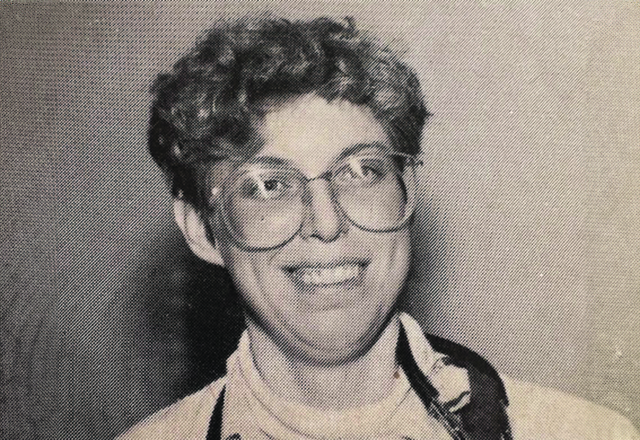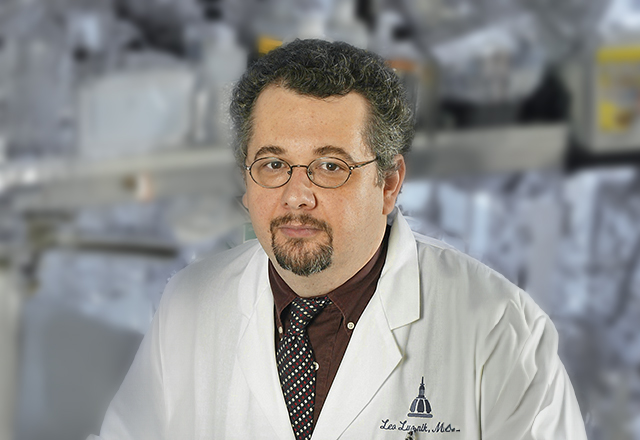Bone Marrow Transplant
A Half-Century of Translational Team Science
Some of the earliest research at the Kimmel Cancer Center was in bone marrow transplant. In fact, the first human bone marrow transplant at Johns Hopkins occurred in 1968, five years before the formal approval of a cancer center in 1973.
By the time George Santos joined the Cancer Center as the first recruit of its director, Albert Owens, he had been studying bone marrow transplantation as a Navy officer at the U.S. Naval Radiological Defense Laboratory.
While studying the effects of nuclear blasts in research models, Santos observed that high doses of radiation destroyed the bone marrow of mice, but if mice received a transplant of bone marrow from a healthy mouse, the donor marrow took over and the mouse could survive.
This led to the idea of bone marrow transplants in humans — killing cancer-filled marrow and replacing it with donor marrow.
Conventional wisdom said it would not work, but true to form, researchers in the Cancer Center, led by Santos, were undeterred.
“I recall his tenacity. He was able to inspire people — his staff and patients — to have faith and belief, inch by inch, that they could make progress,” said Georgia Vogelsang, professor emeritus of oncology and a former trainee of Santos.
Santos, who was director of the Cancer Center’s bone marrow transplant program from 1968 to 1994, was a pioneer in the true sense of the word. His early animal studies became the blueprints for advances in bone marrow transplant and other cancer therapies.
Bone Marrow
Bone marrow — the spongey substance deep within our bones — is the factory for all blood and immune cells. Without it, we cannot survive. Diseases, such as leukemia and lymphoma, represent a production failure in the bone marrow factory, where an overabundance of abnormal cells overwhelm and crowd out healthy blood and immune cells.
“The only way to kill the patient’s cancer is to kill the patient’s own bone marrow,” Santos explained.
Patients with leukemia were the first to receive bone marrow transplants at Johns Hopkins. It was personal for Santos. Photographs of many of the patients he treated throughout his career adorned the walls of his office. The photographs tell the story of a translational researcher, whose pioneering research was driven by the desire to help patients desperate to survive.
GVHD Attacks
In the early days, it was commonly said that bone marrow transplantation was as bad — maybe even worse — than the disease. The reason for this characterization was Santos’ greatest foe, a complication known as graft versus host disease (GVHD).
In GVHD, the immune cells within the donor bone marrow did not recognize its new host and waged a vicious attack against vital tissues and organs that could be as lethal as the cancer.
In fact, it was a rotation on the bone marrow transplant unit, where he witnessed firsthand the power of the immune reaction, that lead Drew Pardoll, director of the Kimmel Cancer Center’s Bloomberg~Kimmel Institute for Cancer Immunotherapy, to focus on cancer immunology research.
 Georgia Vogelsang
Georgia VogelsangGVHD often had devastating consequences. Patients were hospitalized for months, and many died. The risk of graft rejection — that no bone marrow would grow back in the patient — and GVHD made bone marrow transplant one of the most intensive and riskiest medical therapies of its time. Still, patients who were candidates for bone marrow transplants had blood cancers that were certain to kill them. A bone marrow transplant might not be successful, but at least it offered some chance of survival.
Overcoming GVHD
Some of the first major progress made by Cancer Center bone marrow transplantation researchers was in learning how to manage GVHD and even how to manipulate it to help fight the cancer. It also gave rise to a type of drug therapy that could reset the bone marrow factory and take the teeth out of GVHD.
 Jones
JonesThis important advance stemmed from pioneering progress by Santos, combining high doses of the drugs busulfan and cyclophosphamide to replace total body radiation and its dangerous toxicities as the method for killing the patient’s diseased bone marrow before transplanting it with healthy donor marrow.
Related studies by Cancer Center investigators John Hilton and Michael Colvin deciphered how cyclophosphamide worked against cancer and paved the way for the drug regimen to become the worldwide standard.
As is often the case with Cancer Center investigators, they took a gamble in pursuit of better outcomes for patients. Researchers at other cancer centers were following similar paths of discovery, but Johns Hopkins experts, inspired by Santos, often sought less conventional approaches to advancing care.
“A whole generation of Hopkins-trained translational scientists looked to George as their intellectual and spiritual mentor,” recalls current bone marrow transplant director, Rick Jones, who says Santos embraced the concept of translational research ahead of other scientists. “George was showing the Hopkins community how to do this long before it was in vogue,” he says.
This important research also hinted at the usefulness of using cyclophosphamide after bone marrow transplant to control the severity of GVHD.
Until the early 2000s, researchers believed that donor marrow must come from a “perfect match,” a family member who had matching immune system components. This, it seemed at the time, was the only way to make the immune cells contained in the donated marrow see its new host — the patient — as self, and prevent severe cases of GVHD. However, such a match could only be found for about half of patients and was a limiting factor in bone marrow transplant being a treatment option for many who could benefit, particularly underserved minority patients. The National Marrow Donor Program was established in 1986 to match unrelated donors to patients who could not find a donor in their families, but many patients were left without donors.
Cyclophosphamide worked against cancer and paved the way for the drug regimen to become the worldwide standard.
Half-Matched
 Fuchs
FuchsThe portfolio of research expanded, and combined, it led to a paradigm shift — one that overcame the need for a fully matched donor and made bone marrow transplant possible for all patients who needed the treatment.
For decades, GVHD prevented bone marrow transplants from being performed on patients who did not have a fully matching donor.
Pioneering discoveries led by Jones and his Kimmel Cancer Center colleagues Ephraim Fuchs and Leo Luznik changed everything, and against all prevailing thought in the field, made it possible for almost any patient to receive a transplant.
 Luznik
LuznikClinical studies showed that when immune cells, called T cells, were removed from the transplant, patients did not get GVHD, but their cancers sometimes came back. It was one of the first observations of the immune system’s ability to kill cancer cells. The challenge was to remove a precise amount of T cells — small enough to avoid the most severe cases of GVHD yet a large enough number to allow the immune system to keep the cancer from coming back.
It turns out that cyclophosphamide, the same drug used to treat patients before bone marrow transplant, could be given post-transplant to limit GVHD without hampering the T cell’s ability to mop up any surviving cancer cells. This discovery led Kimmel Cancer Center experts to develop a new type of bone marrow transplant, known as a haploidentical or half-identical transplant.
 Brodsky
BrodskySome of the first clues to how cyclophosphamide works began in the 1980s by Michael Colvin and Allan Hess, and were expanded later by Fuchs, Luznik, Jones, Robert Brodsky and Javier Bolaños Meade. They found that cyclophosphamide kills all of the donor’s transplanted bone marrow cells except for stem cells containing high levels of an enzyme called aldehyde dehydrogenase (ALDH). The ALDH-laden stem cells evade the toxic effects of cyclophosphamide and rebuild the patient’s immune system.
Another Breakthrough
This breakthrough approach meant almost all parents, siblings and children of patients — and sometimes even aunts and uncles, nieces and nephews, half-siblings, and grandparents or grandchildren — could safely serve as donors.
Kimmel Cancer Center experts have performed over 2,000 half-matched transplants for adult and pediatric leukemia and lymphoma.
Since developing the treatment more than two decades ago, Kimmel Cancer Center experts have performed more than 2,000 half-matched transplants for adult and pediatric leukemia and lymphoma.
These clinical studies have proven so successful, with safety and toxicity comparable to matched transplants, that the therapy is now used to treat chronic but debilitating noncancerous diseases of the blood in adults and children, such as sickle cell anemia and severe autoimmune disorders.
More recently, a revolutionary study using half-matched transplants to improve the effectiveness and safety of solid organ transplants with living donors has begun. Kimmel Cancer Center researchers are collaborating with transplant surgeons to begin a combined kidney/half-identical bone marrow transplant. Since the patient and donor would have the same immune system, it could essentially eliminate organ rejection and a lifetime of antirejection drugs.
“GVHD limited the ability to do mismatched transplants in the past, but today, it is so well-managed — in large part due to cyclophosphamide — that nearly 95% of patients survive transplant, providing results in unmatched transplants that are the same or better than matched transplants,” says Jones, director of the Kimmel Cancer Center’s bone marrow transplant program. “It all started with Al Owens and George Santos 50 years ago.”
Milestones in Bone Marrow Transplantation and Hematologic Malignancies
1968: Cancer Center performs first bone marrow transplant
1977: Cyclophosphamide and busulfan drug becomes alternative to total body radiation as preparative regimen, eventually overtaking it as the most commonly used regimen for transplant
1980: Post-transplant cyclophosphamide found to prevent GVHD in mice and rats
1981: Acyclovir proven effective against common post-transplant viral infection
1984: Discovery of CD34 antibody makes it possible to isolate and collect bone marrow stem cells
1986: The cancer cell-purging drug 4-HC makes autologous (self-donor) bone marrow transplants possible
1989: Combining AZT with bone marrow transplant clears HIV in a patient with AIDS, and the first umbilical cord blood transplant for leukemia is performed
1990: Mild GVHD is found to boost disease-free survival
1993: Elutriation, which removes T cells while preserving stem cells, reduces bone marrow transplant complications and hospital stays
1994: Epstein Barr-Virus is used to mobilize the immune system against cancer cells, and a Center-developed technique shows that almost all AIDS-related brain lymphomas, about half of Hodgkin’s lymphomas and all nasopharyngeal cancers contain the virus
1995: Nurse-developed and run Inpatient/Outpatient (IPOP) bone marrow transplant center opens, and the pediatric bone marrow transplant center opens
An enzyme called ALDH protects blood stem cells against cyclophosphamide
2000: First half-matched bone marrow transplant with post-transplant cyclophosphamide
2002: High-dose cyclophosphamide shown to successfully treat severe aplastic anemia and other noncancer diseases
2014: Half-identical bone marrow transplant proven as safe and effective as fully matched bone marrow transplants
2023: Based on 50 years of research, post-transplant cyclophosphamide becomes the new standard of care for GVHD, and is reported in the New England Journal of Medicine.
